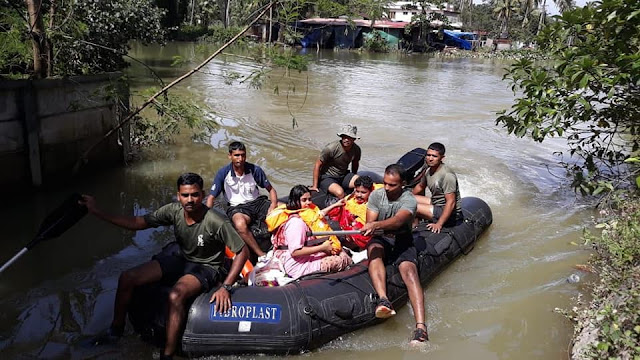She shot
to prominence recently at IAAF World U20
Championships - India's Hima Das made history by becoming the country's first
track athlete to become a world champion at any level after winning the women's
400m at the U-20 World Championships in Tampere, Finland. Hima is also only the
second ever Indian athlete to claim a gold medal at the World Juniors,
following javelin thrower Neeraj Chopra's victory at the 2016 edition of the
championships. With a power-packed finish, India’s Hima Das sealed her nation’s
first ever medal in the 400m at the IAAF World U20 Championships,
sling-shotting to the lead down the home straight and coming home a clear
winner in 51.46.
Today at
Ageas Bowl, Southampton, a minute ago,
Indians were all out for 273 – India
struggled against Mooen Ali who had a 5 wicket haul – Pujara remained unbeaten
at 132; Ishant and Bumrah had good partnerships with Pujara. Rishab Pant, a known aggressor, played a
rather uncharacteristic innings, remained without scoring and got out after 29
balls. Yesterday Kumara Dharmasena, ruled batsman notout to Ashwin delivery –
India went on appeal – legitimate delivery, ball was in line and went on to
clip the wickets – but as the decision was not out and since there was doubt on
whether the ball straightened enough, Dharmasena was given the luxury of
retaining his decision and he promptly declared batsman not out .. .. if the
system cannot throw a result on whether ball straightened, how did it show that
ball would for sure clipped the wickets.
Today it was more eerie. Ajinkya
Rahane was given out lbw and went on appeal. Ben Stokes appeared to have
overstepped as no part of his foot was beyond the crease – yet Bruce Oxenford
struck to his decision after review ruling Rahane out and triggering a collapse
!
The
Port of Southampton is a major passenger and cargo port located in the central
part of the south coast of England. It benefits from a sheltered location,
unique "double tides", close proximity to the motorway network and
good rail links. It is the busiest
cruise terminal and second largest container port in the UK. The port is
located ten miles (16 km) between the confluence of the rivers Test and Itchen
and the head of the mile wide inlet
known as Southampton Water. It has a long history - It is stated citing
archaeological findings that the area has been inhabited since the stone age. During
the Middle Ages, shipbuilding became an important industry for the town. Henry
V's famous warship HMS Grace Dieu was built in Southampton. The port had been
used for military embarkation, including during 18th-century wars with the
French. In 1912, the ill-fated RMS Titanic sailed from Southampton. The Supermarine Spitfire was designed and
developed in Southampton. Heavy bombing
of the factory in September 1940 destroyed it as well as homes in the vicinity,
killing civilians and workers. World War II hit Southampton particularly hard
because of its strategic importance as a major commercial port and industrial
area.
Now at Asian Games,
Hima's outstanding sprint in the final
stretch of her part along with the efforts of teammates Machettira Poovamma,
Saritaben Laxmanbhai Gayakwad and Velluva Koroth Vismaya helped India retain
their title. India now have 58 medals at Asian Games 2018 and 12 gold medals.
Gelora Bung Karno
Main Stadium is a multi-purpose stadium located in Central Jakarta, Indonesia. The stadium is
named after Sukarno, Indonesia's first President. It is mostly used for
football matches. When first opened in 1962, the stadium had a seating capacity
of 110,000. It has been reduced twice. The
athletics competitions of 2018 Asian
Games was held at Gelora Bung Karno Stadium, Jakarta,
Perhaps, everything
played out as per script for the Indian women in the 4x400m relay on the final
day of the athletics programme at the 2018 Asian Games. Hima Das, the fastest
quarter-miler in the country, gave the lead on the first lap with a searing
run, setting a heady tone for the whole race, which the rest did well to
consolidate, leaving their opponets in a helpless wake. Clocking an impressive
3:28.72s, they ensured India won its fifth 4×400 relay gold medal at the Asian
Games on the trot.
For Hima, who
celebrated wildly, it was her first gold medal at the Games after enduring
heartbreaks in 400m and 4x400m mixed relay. On both instances she had to settle
for silver. Seasoned runner MR Poovamma, the only member from the previous
winning squad that set a games record with an effort of 3.28.68, took the baton
from the Assam girl and ensured India didn’t lose the advantage. From there on,
victory seemed certain and the only question was about the margin.
Bahrain (3:30.61s)
finished almost two seconds behind India while Vietnam could manage 3:33.23s
for the bronze. The Indian women missed the Games record of 3:28.68s by a very
narrow margin. What makes the gold even
more glittering is that they are a young group. Poovamma, at 28, is the oldest.
Sarita Gayakwad is 24, Hima 18 and VK Vismaya 21. Both Povamma and Hima, who
undoubtedly is among the most promising young athletes in the continent, had on
Wednesday claimed silver in the 4x400m mixed relay as well.
Their collective
effort kept a proud Indian legacy intact in the Asian Games—they have topped
the particular stream in every edition of the event since 2002 edition in
Busan, where a talented group of Jincy Phillip, Manjeet Kaur, Soma Biswas and
KM Beenamol ran terrifically.
Well done Indian
athletes
With regards – S.
Sampathkumar
31st Aug
2018 @ 22:30 hrs.












